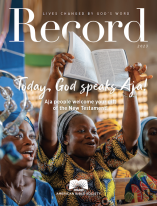2 Ideas that Changed How I Read Scripture
Findings on Bible engagement from the RightNow Conference
The RightNow Conference gathered about 3,000 church leaders at Bent Tree Bible Fellowship in Carrollton, TX, for three days of worship, talks, and workshops November 4-6. Plenary speakers included an impressive array of nationally known pastors and authors—Batterson, Chan, Greear, Horton, Metaxas, to name a few.
Reading the Bible with Holy Desire
I was on the lookout for Bible engagement, and I found it in a workshop entitled “The Word Became Flesh: Why ‘Matter’ Matters in Scripture.” It was led by author Jen Pollock Michel, who urged us to recognize “the materiality of the biblical landscape.” Scripture is full of rich imagery—tastes and sounds and things. We tend to read the Bible conceptually and behaviorally. We look for ideas and commands—and we ignore the matter that could make the Bible very real to us.
Michel compared our discipleship models to three characters from The Wizard of Oz.
The Scarecrow sings, “If I Only Had a Brain,” and many of us try to infuse information into people’s brains. “Scarecrows need right beliefs,” Michel said, and so “we give them necessary information.”
The Cowardly Lions among us lack the courage to behave morally. We teach them to do the right thing. In this discipleship model, Michel says, “Scripture is a list of commands.”
She promoted a third way, that of the Tin Man, who focused on the heart. “Holy desire” is a major theme of Michel’s book, Teach Us to Want (IVP, 2015), and here she urged us to “put desire in its rightful place” in our discipleship training. “How do we form desire? When things are embodied for us, they move us.” With that, she brought us back to the physicality of Scripture, to the names and places, the sights and smells of the biblical terrain. The altars, wells and rocks. Sarah’s laughter. Ideas stir our brains and commands guide our actions, but we want to be people after God’s own heart. So let’s not just translate the Bible’s matter into concepts or rules. Let matter matter.
Contextualizing the Bible and its Readers
In another workshop, Philadelphia pastor Eric Mason spoke about “Contextualization: Reaching Out Without Selling Out.” He was applying his ideas to church ministry, especially in an urban context like his own, but I saw a strong connection to Scripture content.
Mason compared undercontextualization (which assumes all people are alike and fears that any adjustment in communication will change the gospel message) to overcontextualization (which assumes that relevance requires removing all offense from the gospel). Holding up the incarnation of Jesus as a model, Mason urged us to recognize cultural differences and to “remove every obstacle that inhibits our ability to lovingly engage people.”
As we seek to communicate the truths of Scripture in these times, we can’t assume that people still fit the culture of twenty, forty, or two thousand years ago. They may not know where to find Habakkuk or how the New Testament is different from the Old or what the word “saved” means. We desperately need to contextualize—not only for different ethnic groups, but also for generations that have grown up without the Bible. It’s not a question of dumbing down the gospel or removing its offense, but finding how biblical truth plays out amid the realities of modern life.
Thanks to the support of our faithful financial partners, American Bible Society has been engaging people with the life-changing message of God’s Word for more than 200 years.
Help us share God's Word where needed most.
Connect with our Bible engagement blog for leaders and receive a Bible-reading Habit Guide for your community.









